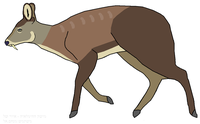
Photo from wikipedia
Himalayan or White-bellied Musk Deer Moschus leucogaster, an IUCN indexed endangered species, is distributed in isolated pockets in the Himalaya. The deer population is decreasing owing to several pressures that… Click to show full abstract
Himalayan or White-bellied Musk Deer Moschus leucogaster, an IUCN indexed endangered species, is distributed in isolated pockets in the Himalaya. The deer population is decreasing owing to several pressures that include habitat loss and fragmentation, and poaching. It is essential to identify preferred habitat characteristics to support appropriate management strategies for conserving this endangered species. This study was carried out in the Nysheang basin of Annapurna Conservation Area of Nepal to identify habitats preferred by the musk deer. Habitat field parameters were collected using transect surveys. To analyze vegetation use and availability, nested quadrate plots size 20 m2 were established. Ivlev’s electivity index (IV) (-1 to +1) was employed to determine habitat preference, and one-way ANOVA (F) and chi-square tests (χ2) were used to examine different habitat parameters. Similarly, the importance value index (IVI) of the vegetation was calculated. Our results showed that the Himalayan Musk Deer strongly preferred habitats at 3601–3800 m altitude (IV= 0.3, F= 4.58, P <0.05), with 21–30º slope (IV= 0.2, F= 4.14, P <0.05), 26–50 % crown cover (IV= 0.25, F= 4.45, P <0.05), 26–50 % ground cover (IV= 0.15, F= 4.13, P <0.05), and mixed forest (IV= 0.29, χ2= 28.82, df= 3, p <0.001). Among the trees, Abies spectabilis (IVI= 74.87, IV= 0.035) and Rhododendron arboretum (IVI= 55.41, IV= 0.02) were the most preferred, while Rhododendron lepidotum, Cassiope fastigiata (IV= 0.35) and Berberis aristata (IV= 0.25) were the most preferred shrubs, and Primula denticulata (IV= 0.87) and Primula rotundifolia (IV= 0.31) were the most preferred herbs. These preferred habitat conditions should be maintained and conserved to sustain a viable population of deer in the study area. Further studies will be required to assess the effects of climate change on habitat suitability.
Journal Title: Journal of Threatened Taxa
Year Published: 2021
Link to full text (if available)
Share on Social Media: Sign Up to like & get
recommendations!